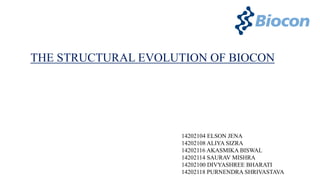Biocon ppt 1
- 1. 14202104 ELSON JENA 14202108 ALIYA SIZRA 14202116 AKASMIKA BISWAL 14202114 SAURAV MISHRA 14202100 DIVYASHREE BHARATI 14202118 PURNENDRA SHRIVASTAVA THE STRUCTURAL EVOLUTION OF BIOCON
- 10. Conclusion 1. Organisation structure changes from time to time. Even if we consider The case of Biocon, it’s structure also changed since the day of it’s establishment. 2. When Biocon was first established in India, it had a very Simple structure whose Key part was the Strategic Apex. Formalization was Low, Complexity was low but Centralization was high 3. Biocon Opened it’s Subsidiaries Syngene in 1994 and Clinigene in 2000.Currently it has a Divisional Bureaucracy where Middle Line is the Key Part. Formalization has become high as well as the Complexity.But Due to Middle line it has limited horizontal decentralization. It is highly functional. 4.Biocon is also having Adhocracy were the key part is the Support Staff in which 40% are holding a Master’s degree & 5% are holding a post doctoral degree with basic focus on R&D.
- 12. Question Q.1)The evaluation of this organization and its thirty-year journey makes one wonder how the corporate and organizational structure will look by2015?
- 13. Answer
- 14. Q.2) Will kiran’s organization continue to be effective in the long run?
- 15. Answer
- 16. Conclusion
















